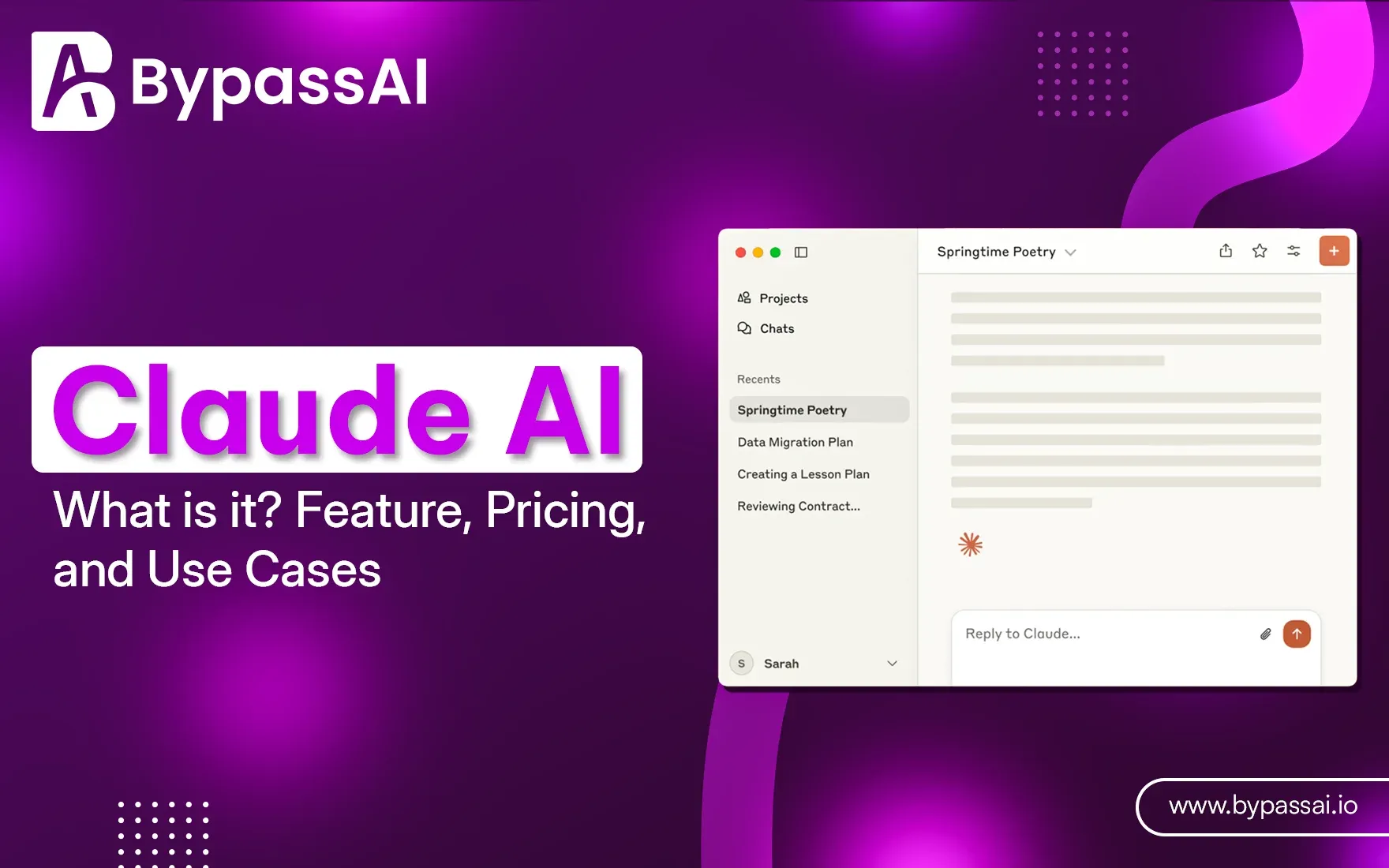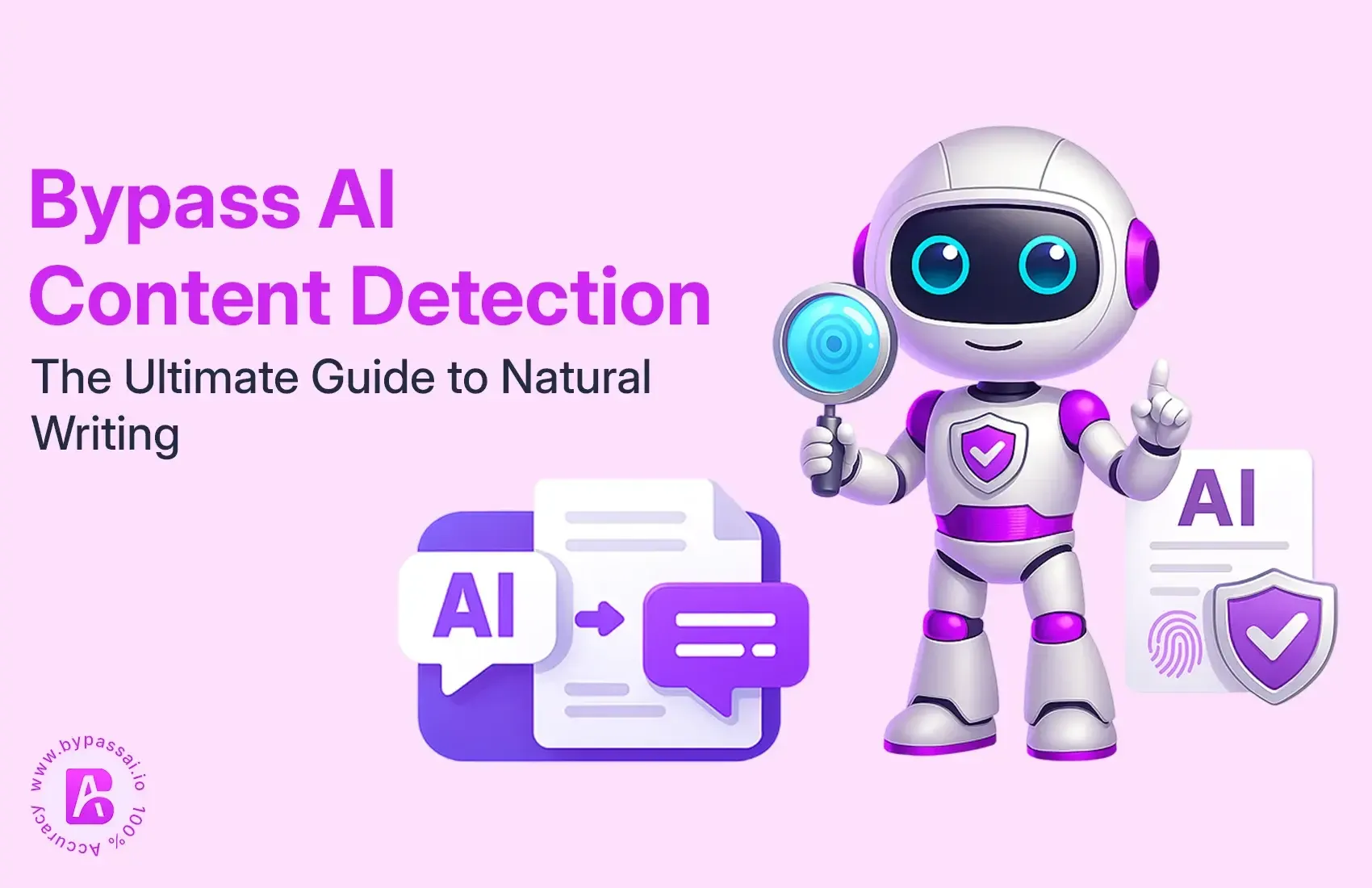Sign In
Welcome to Bypass AI! Sign in to continue your exploration of our platform with all its exciting features.
Forgot Password?
Don’t have an account ? Sign up
Sign Up
Embrace the Future with Bypass AI! Sign up now and let's rewrite the possibilities together.
You have an account ? Sign In
Enter OTP
We’ll send you an OTP on your registered email address
Back to Login
Forgot Password
We'll Send You An Email To Reset Your Password.
Back to Login
Enter OTP
We'll send you an email to reset your password.
Back to Login
Confirm Password
Please enter your new password.
TABLE OF CONTENTS
Quick Summary
What is Claude AI?
Who Created Claude AI?
Claude AI Models & Versions
How does Claude AI work?
Which is better: Claude AI or ChatGPT?
How to use Claude AI: 6 ways to get started
Key Features of Claude AI
Advantages of Using Claude AI
Limitations of Claude AI
How much does Claude AI cost?
Future of Claude AI
Real-Life Examples / Case Studies
Conclusion
FAQs
It would not be wrong to say that Artificial Intelligence has completely transformed our work and learning. In the last one or two years, conversational AI tools like ChatGPT, Grok have gained a lot of popularity among professionals. But among these, there is one such tool which is quite advanced, its name is Claude AI. The best thing about this platform is that it has been designed with ethics and safety in mind. Cloud is becoming the favourite platform of students, professionals, and developers.
When I used the Claude platform, I noticed one thing that their main focus is on advanced results, not on the interface, because the overall interface of the Claude platform is quite simple, but its result accuracy is quite high. The rest of the LLM tools give natural results, but in Claude, your conversation will feel quite natural. Claude can answer massive data with context awareness. When you write 2-3 new texts in ChatGPT, it does not have the previous context, but Claude's context awareness is much better than this.
Let's understand the Cloud platform in detail, what unique features and pricing you get in it.
Quick Summary
There are many LLM models available in the market, and each has its own features and uniqueness, but in the last 1 year, Anthropic’s Claude AI has become quite popular due to its safe, ethical and capabilities as it can easily handle long inputs. It is also becoming so popular because it offers the largest context window, which is 200,000 tokens, roughly 350 pages, hence, it is becoming the best option for research, document analysis, and long-form content.
Cloud Chat is also quite different from GPS as its main focus is on safety and privacy, which makes it quite suitable for business use.
Our Focus in this article:
- What is Claude AI, and how does it work?
- What are the uses of Claude AI, and who uses it?
- What is the pricing of Claude AI?
What is Claude AI?
Claude AI is a next-generation AI Chatbot built by Anthropic company and is known for its AI safety and ethics. The Claude platform is known for Large Language Models and advanced algorithms, and it can understand human context and give you human-like answers accordingly.
So even if you are a student or a casual user, you can use it as an AI assistant. You can use it for your creative tasks, tough concepts, writing code, and to summarize long reports. It handles context-aware conversations quite well. If you are also concerned about privacy and ethical usage of AI, then you can prefer Claude AI.
Mostl,y the previous memory of LLM models is not that sharp, but the previous memory of Claude AI is quite sharp and of high quality, which is why I prefer Claude AI for my long context queries.
Who Created Claude AI?
Claude AI is the brainchild of Anthropic AI, a San Francisco-based startup founded in 2021. Anthropic was started by ex-OpenAI members, including Dario and Daniela Amodei, both of whom played key roles in building GPT-3 at OpenAI.
Why did they leave OpenAI? The main reason was safety concerns. The Amodei siblings and their team believed that AI was advancing so quickly that proper safeguards weren’t being prioritized.
They wanted to create AI that wasn’t just powerful but also aligned with human values. That’s how Anthropic was born. Today, Anthropic is valued at around $20 billion and has received massive investments from Google and Amazon (around $4 billion). Unlike many tech startups, Anthropic is structured as a Public Benefit Corporation, meaning it has a legal responsibility to prioritise safety and public good, not just profit.
Claude AI, a chatbot designed to be reliable, ethical, and safe for both individuals and enterprises.
Claude AI Models & Versions
Claude isn’t just one model; it’s a family of models, each with its own strengths. Over time, Anthropic has released multiple versions, improving both performance and safety.
Claude 1 (2023): The first official release, showing the world how Constitutional AI works. It was more aligned and cautious compared to ChatGPT’s earlier models.
Claude 2 (2023): A major upgrade. This model significantly boosted Claude’s reasoning abilities and long-context handling (up to 100,000 tokens). When I tested it, I noticed it was much better at analyzing research papers and writing professional documents.
Claude Instant: A lighter, faster, and cheaper version of Claude. Perfect for quick responses and everyday use, though slightly less powerful than Claude 2.
Claude 3 (2024/2025 updates): Anthropic has been rolling out even more powerful iterations, expanding Claude’s speed, reasoning, and ability to process up to 200,000 tokens. That’s equivalent to reading 350 pages at once.
When compared to ChatGPT:
- Claude Instant is like GPT-3.5 (fast, but less capable).
- Claude 2/3 competes directly with GPT-4.
What I really like is that Claude gives free users access to its strongest models, unlike ChatGPT, which reserves GPT-4 for paid users.
How does Claude AI work?
At its core, Claude AI is powered by a Large Language Model (LLM), which is essentially a super-advanced algorithm trained on massive amounts of text data. Like ChatGPT and other AI models, Claude is based on the transformer architecture, a breakthrough system that uses “attention” mechanisms to understand the context of words and sentences.
But here’s where Claude sets itself apart:
1. Training Data: Claude was trained using a combination of publicly available internet data, licensed datasets, and specially prepared examples by human trainers. This allows it to understand not just everyday conversation but also academic, technical, and business contexts.
2. Constitutional AI: This is Claude’s “ethical compass.” Unlike ChatGPT, which uses reinforcement learning from human feedback (RLHF), Claude was trained on a set of written principles (its “constitution”) that guide its behaviour. These principles encourage responses that:
It respects privacy and human rights.
It avoids harmful or biased outputs
It promotes honesty, helpfulness, and safety
In my experience, this makes Claude much less likely to generate inappropriate or harmful responses compared to other AI tools.
3. Context Window: Claude can handle up to 200,000 tokens (about 350 pages of text). This is a game-changer. For example, I once uploaded a full technical report of 120 pages and asked Claude to summarize the key findings, and he delivered a concise, accurate summary that would have taken me hours to prepare manually.
4. Speed and Efficiency: With Claude 3, Anthropic claims the model can process around 30 pages of text per second. That means even if you upload a long research paper, you’ll get results almost instantly.
So if I had to explain it in simple terms: Claude AI works by analyzing your input, applying its ethical principles, and generating contextually aware, human-like text at scale. It’s like having a highly ethical, super-fast assistant who remembers what you said even after hours of conversation.
Which is better: Claude AI or ChatGPT?
Many of my colleagues have this question, which LLM is the best, ChatGPT or Claude? The answer to this depends on many factors; let's know it in detail.
Where Claude AI wins
1. Long Context Handling: Claude can read and analyze entire books or long research papers without losing track. ChatGPT struggles when the input gets too large.
2. Ethics and Safety: Thanks to Constitutional AI, Claude tends to produce more careful and balanced answers. This is especially useful for businesses and educators who want safe, reliable content.
3. Privacy: By default, Claude doesn’t use your data for training unless you explicitly allow it. ChatGPT, on the other hand, requires you to opt out.
4. Free Tier Strength: Free users of Claude get access to its best model (Claude 2 or later). ChatGPT only gives GPT-3.5 for free, reserving GPT-4 for paid users.
Where ChatGPT wins
1. Features & Ecosystem: ChatGPT Plus includes extras like image generation (via DALL·E), browsing, voice chat, and plugins. Claude currently lacks these.
2. Internet Access: ChatGPT can fetch real-time information via Bing integration. Claude cannot yet access the internet directly
3. Customization: OpenAI allows users to create custom GPTs and use plugins, while Claude doesn’t currently offer fine-tuning or plugin support.
4. Speed in Quick Conversations: While Claude excels at long-form tasks, ChatGPT often feels snappier for casual, short queries.
Benchmarks and Performance:
Independent tests like LMSYS Chatbot Arena leaderboard show that Claude outperforms ChatGPT’s free GPT-3.5 model in most benchmarks (reading comprehension, reasoning, and summarization). However, GPT-4 is still the leader overall in raw intelligence and versatility.
So which is better?
If you’re a researcher, writer, or professional working with large documents, Claude is the smarter choice.
If you need creative features, internet browsing, or voice/image tools, ChatGPT Plus has the edge.
Personally, I use both side by side, depending on the task. For my deep work and professional projects, Claude feels like the more reliable partner. For quick searches or creative brainstorming, ChatGPT is still incredibly useful.
How to use Claude AI: 6 ways to get started
Using Claude is simple; just sign up at Claude.ai and start chatting. But beyond simple Q&A, Claude really shines when you use it creatively. Here are six powerful ways to get started:
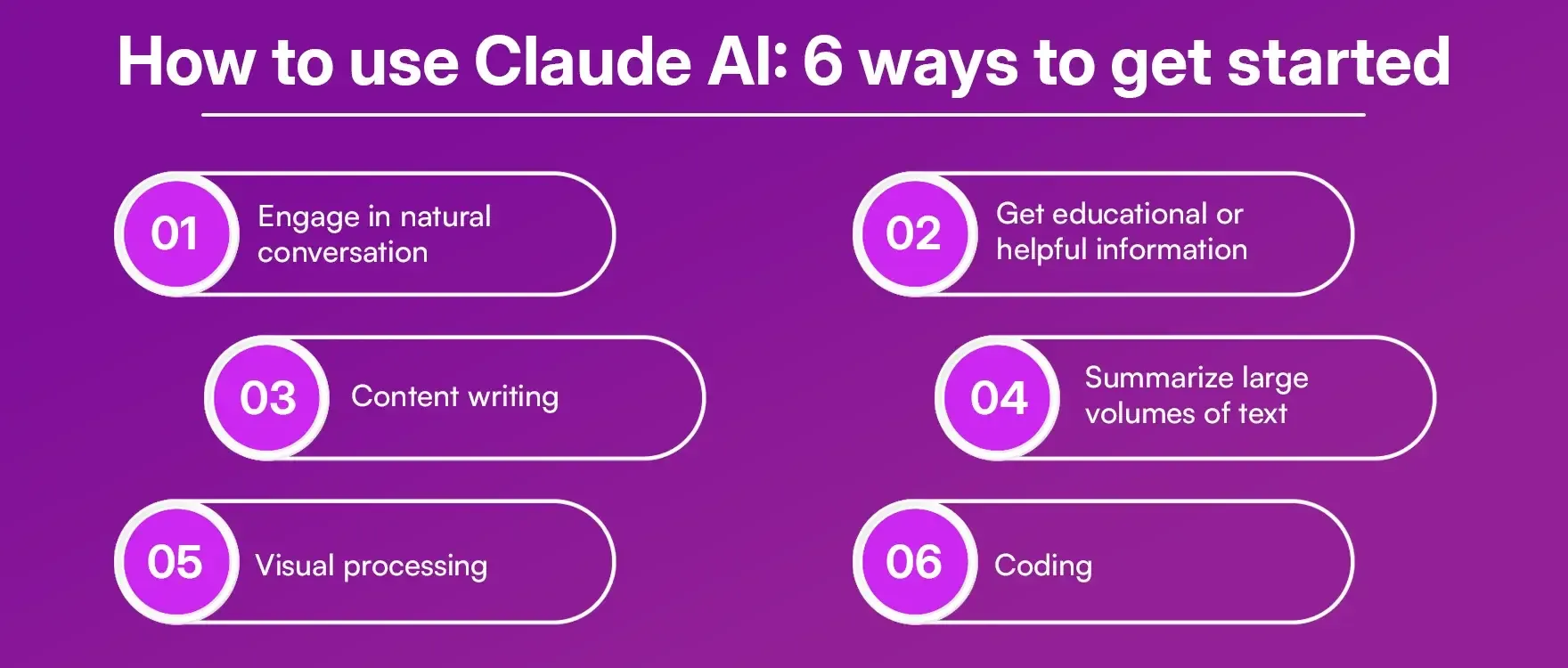
1. Engage in natural conversation
Claude isn’t stiff or robotic; it understands slang, idioms, and even humour. I’ve had casual chats where it helped me brainstorm party ideas and even explained philosophical paradoxes like Schrödinger’s Cat in plain English.
2. Get educational or helpful information
Need to learn something quickly? Claude can act like a tutor. For example, I asked it to explain European history in simple terms for a beginner, and it broke down events into timelines and key figures. You can also ask for step-by-step guides, like how to mount a TV or how to cook homemade pasta.
3. Content writing
This is one of Claude’s strongest areas. You can draft business reports, blog posts, stories, emails, or scripts by simply describing what you want. In my workflow, I often provide Claude with a style guide or past examples, and it adapts seamlessly.
4. Summarize large volumes of text
This is hands-down my favourite feature. Upload a PDF, transcript, or long article, and Claude will give you clear, concise summaries. For instance, I once uploaded a 50-page technical whitepaper and got a 3-page summary with bullet points that captured all the essentials.
5. Visual processing
Unlike its early versions, Claude can now accept image uploads. You can ask it to describe an image, transcribe handwritten notes, or even analyse a photo of a historical plaque. This makes it useful for accessibility, research, and creative inspiration.
6. Coding
Claude is excellent with programming tasks, especially Python. I’ve used it to:
- Debug old code
- Write new functions
- Explain what specific code snippets do
- Suggest improvements based on best practices
It’s like having a coding mentor who doesn’t get tired of your endless “why does this error keep showing up?” questions.
Key Features of Claude AI
When I first started using Claude, what surprised me was how feature-packed it is despite being marketed as a “simple chatbot.”
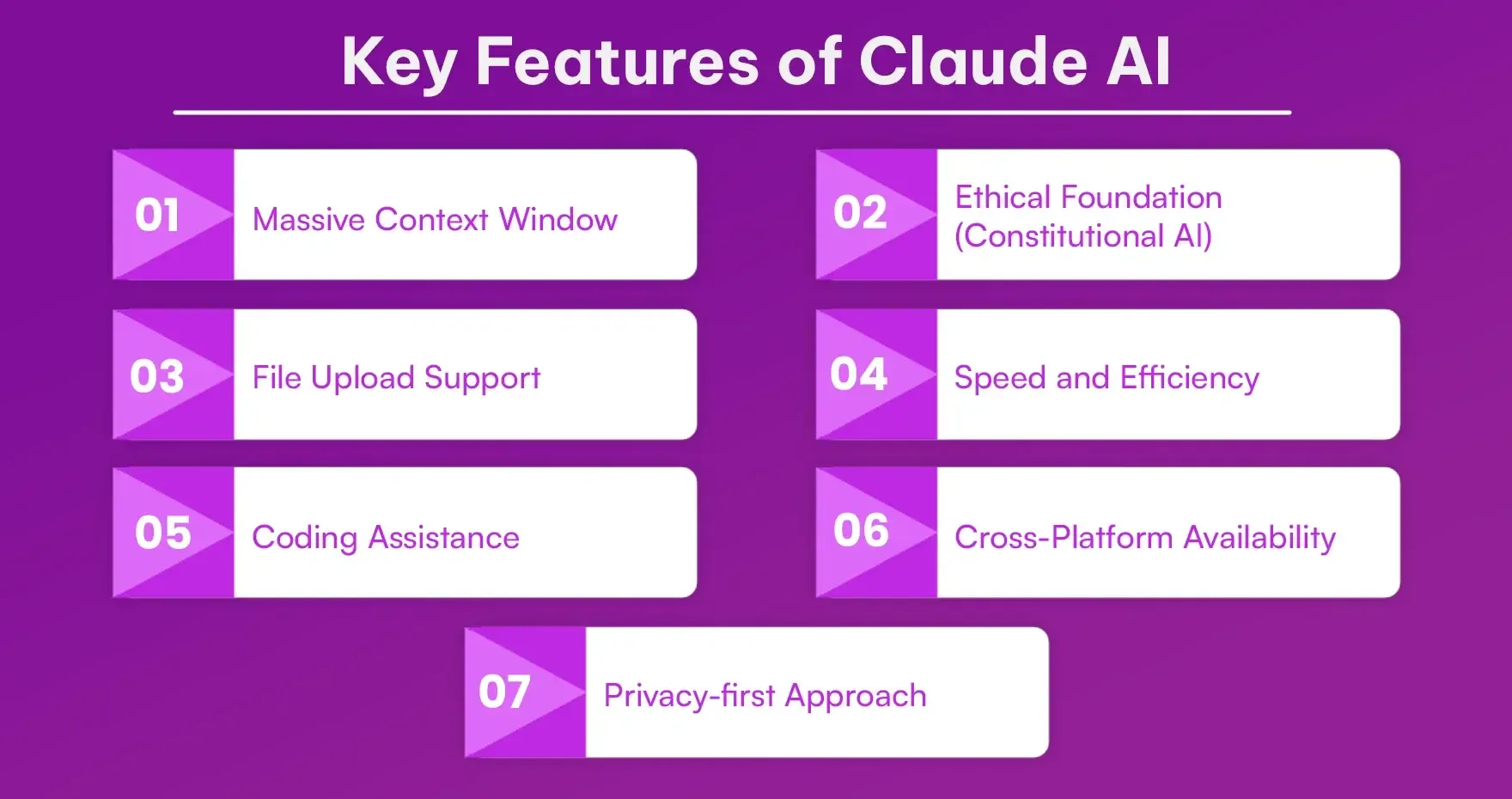
Here are some standout features that make it different:
1. Massive Context Window: Claude can process up to 200,000 tokens (roughly 350 pages). This is game-changing for researchers, students, or professionals who deal with long documents.
2. Ethical Foundation (Constitutional AI): Instead of just generating raw text, Claude follows guiding principles that ensure its responses are helpful, honest, and harmless.
3. File Upload Support: You can upload PDFs, Word docs, CSVs, or text files, and Claude will analyze, summarise, or explain them in detail.
4. Speed and Efficiency: Claude 3 can process around 30 pages per second, which means no more waiting ages for long reports to be analyzed.
5. Coding Assistance: Claude isn’t just about text. It’s particularly strong in Python programming, debugging, and explaining complex code in simple terms.
6. Cross-Platform Availability: You can access Claude on the web, through API integrations, and even in collaboration platforms like Slack.
7. Privacy-first Approach: By default, Anthropic does not use your data for training unless you give explicit permission. Conversations are also stored for a limited period (typically 30–90 days).
In short, Claude is not just “another chatbot”, it’s a multi-functional assistant built with reliability and safety in mind.
Advantages of Using Claude AI
After months of experimenting with Claude, here are the biggest benefits I’ve seen:
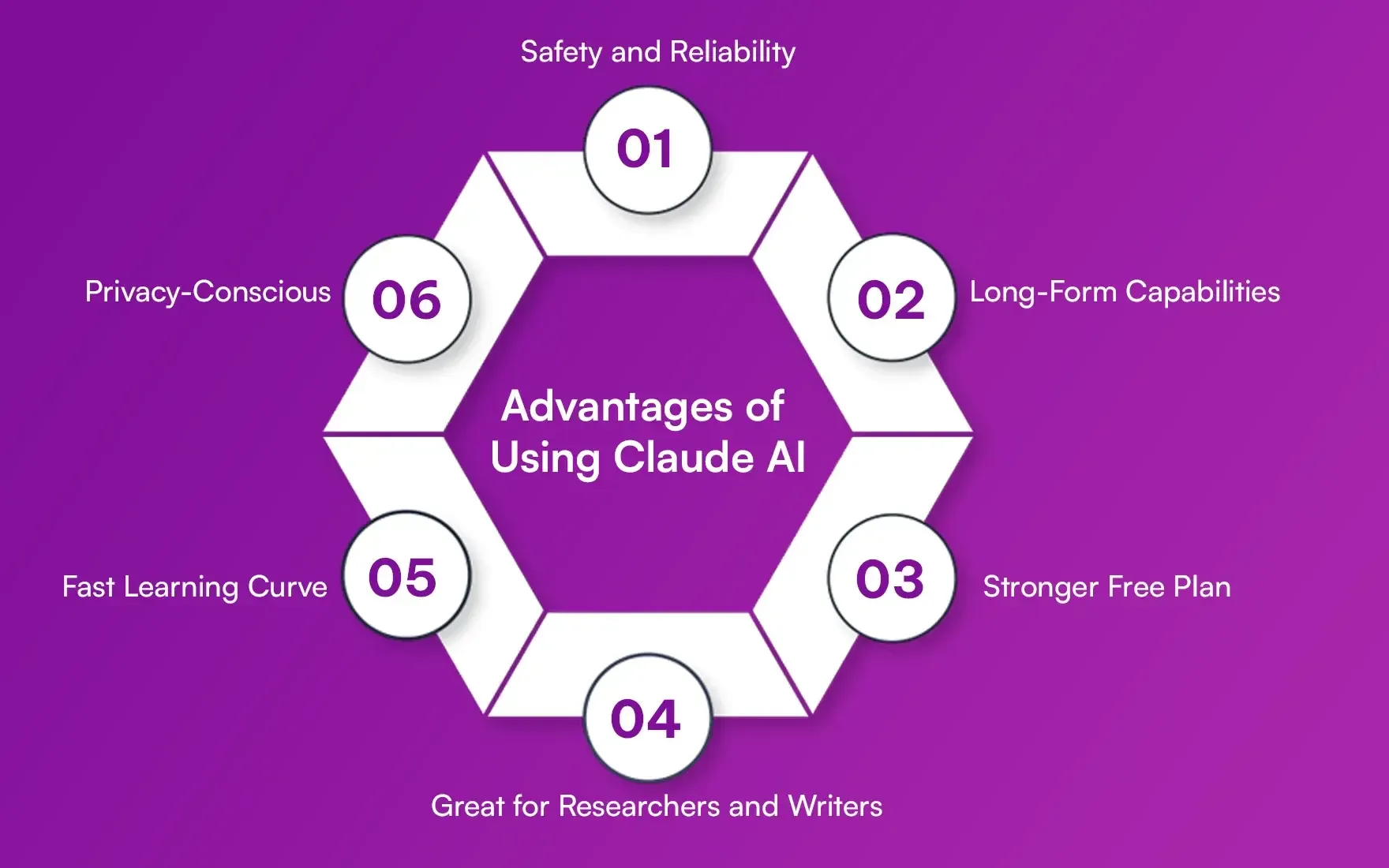
1. Safety and Reliability: Thanks to Constitutional AI, Claude rarely gives unsafe or biased answers. I’ve found it much more consistent in professional use.
2. Long-Form Capabilities: Unlike ChatGPT, which sometimes forgets things in long chats, Claude remembers and handles multi-turn conversations better.
3. Stronger Free Plan: Free users can still access Claude’s latest and best model. This is rare, as most companies lock advanced models behind paywalls.
4. Great for Researchers and Writers: Claude’s ability to process hundreds of pages makes it an incredible tool for summarization, academic research, and professional writing.
5. Fast Learning Curve: The interface is clean and distraction-free. Even a beginner with no AI experience can start using Claude effectively within minutes.
6. Privacy-Conscious: If you’re worried about your conversations being used for AI training, Claude is the safer option compared to most competitors.
Limitations of Claude AI
Of course, no AI tool is perfect. Here are the drawbacks I’ve noticed with Claude:
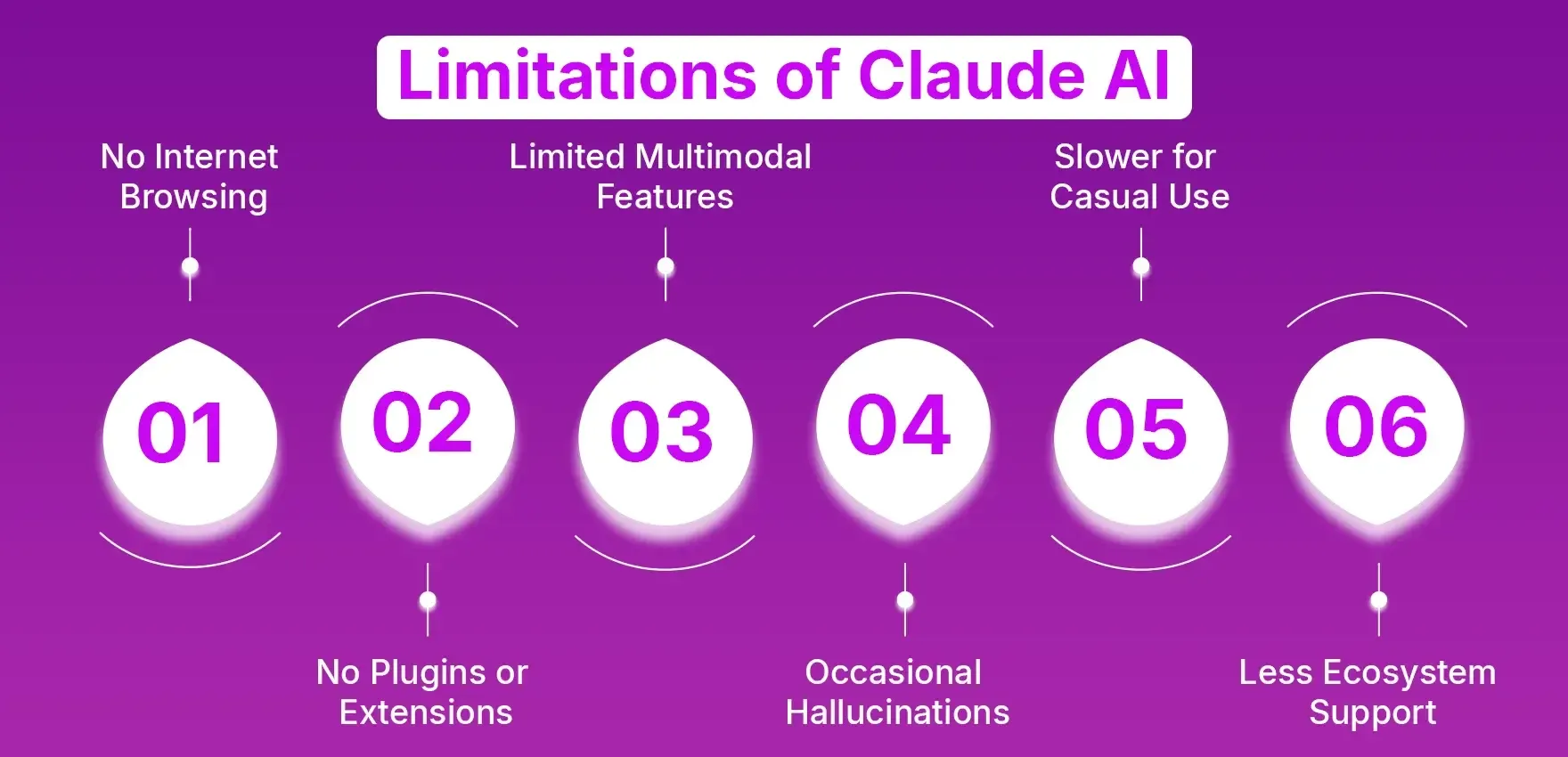
1. No Internet Browsing: Claude cannot fetch real-time data from the web. So if you ask about breaking news or the latest stock prices, it won’t help.
2. No Plugins or Extensions: Unlike ChatGPT, which offers plugins for travel, research, and more, Claude doesn’t yet support third-party extensions.
3. Limited Multimodal Features: While Claude supports text and some image inputs, it doesn’t generate images or videos like MidJourney or ChatGPT with DALL·E.
4. Occasional Hallucinations: Like all large language models, Claude sometimes produces factually inaccurate responses. You still need to double-check important outputs.
5. Slower for Casual Use: Because Claude prioritizes careful responses, sometimes it feels slower than ChatGPT for quick, casual chats.
6. Less Ecosystem Support: ChatGPT integrates with apps, APIs, and third-party services more widely, giving it a broader ecosystem.
So while Claude is excellent for accuracy and safety, it may not satisfy users looking for real-time browsing or creative media generation.
How much does Claude AI cost?
One of the things that impressed me about Claude is its pricing strategy. Anthropic offers a free tier with access to its best model, something very few AI companies do.
Here’s the breakdown:
Claude Free: It provides unlimited access to Claude’s latest model (usually Claude 2 or 3) with daily usage limits. Perfect for casual users.
Claude Pro ($20/month): It's comparable to ChatGPT Plus.
It includes 5x more usage than the free plan, Priority access during peak times Early access to new features.
For developers and businesses:
1. API Access via Anthropic: Available on request; pricing depends on token usage.
2. Amazon Bedrock Integration: Claude models are available on AWS with on-demand and provisioned throughput pricing. For example, reserving a dedicated Claude-Instant capacity for one month can cost upwards of $29,000+.
For most users, the $20 Pro plan is more than enough. If you’re running a company or need large-scale API integration, AWS Bedrock pricing applies.
Is Claude AI factually accurate?
This is where things get interesting. Claude is designed to be more cautious and fact-focused, but it’s still not perfect.
1. Strengths: In my experience, Claude is particularly good at summarization and document analysis. It rarely misinterprets data from long inputs.
2. Weaknesses: Like all LLMs, Claude occasionally suffers from hallucinations, generating information that sounds right but isn’t factually correct.
So is it reliable? Yes, more accurate than GPT-3.5 in many tasks, but not flawless. I always recommend fact-checking any critical outputs, especially for business or academic use.
Future of Claude AI
Claude has come a long way since its launch in 2023. And honestly, its future looks very promising.
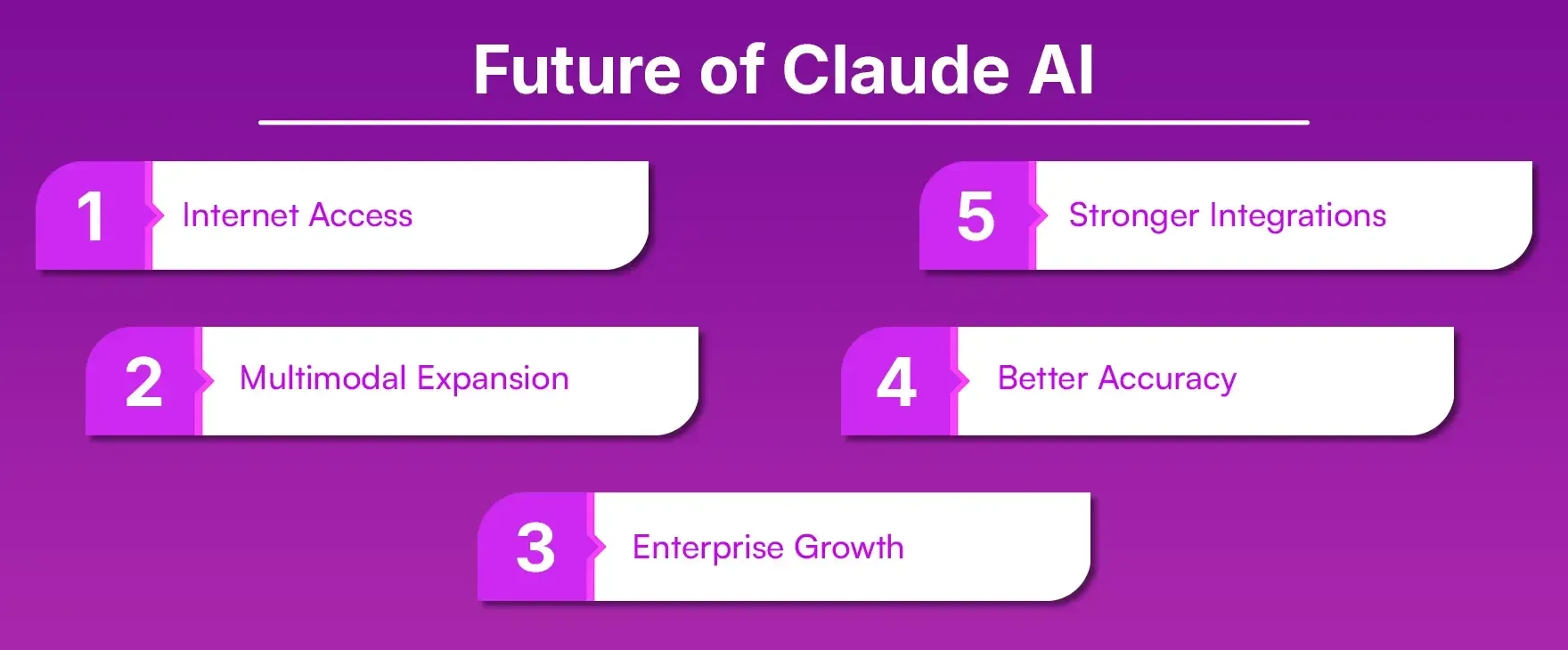
1. Internet Access: Anthropic may eventually add browsing features, especially since competitors already offer this.
2. Multimodal Expansion: Future Claude models could accept and generate not just text, but also images, audio, and maybe even video.
3. Enterprise Growth: With Amazon and Google backing it, Claude will likely expand deeper into business applications, especially through cloud services.
4. Better Accuracy: Anthropic is continuously refining its Constitutional AI framework, which should reduce hallucinations even further.
5. Stronger Integrations: You can expect Claude to show up in collaboration tools (Slack, Notion, Google Workspace) as AI assistants become mainstream.
If things continue this way, Claude might genuinely rival, or even surpass, ChatGPT in terms of adoption.
Real-Life Examples / Case Studies
Academic Research, Students and researchers use Claude to summarize long papers, making literature reviews much faster. I tested this myself with a dense 80-page journal. Claude produced a digestible summary in minutes.
1. Business Reports: Companies are using Claude to generate meeting notes, executive summaries, and policy drafts. One marketing manager I spoke with said Claude helped cut her team’s reporting time by 60%.
2. Software Development: Developers leverage Claude for debugging and writing Python code. Unlike some tools that just dump code, Claude explains the logic step by step.
3. Content Creation: Writers and bloggers (like me) use Claude for drafting outlines, editing, and refining content. What I appreciate is its ability to stay in context even with long documents, unlike many other AI tools.
4. Accessibility Support: Claude’s image analysis feature is helping visually impaired users get descriptions of photos and documents.
These examples prove that Claude isn’t just a “tech demo”; it’s a practical tool making a real impact across industries.
Conclusion
Claude AI is not a random chatbot, but it represents new LLM models that are safe, reliable, and genuinely helpful for everyone. Anthropic company is known for its ethics and user safety, which is why companies prefer Claude. Because, along with data safety, Claude can also easily handle massive contextual documents while ensuring the privacy policy.
Currently, you do not get support for extra features like plugins, voice chat support or internet browsing in Claude, which is why many users prefer ChatGPT, but Claude still provides very advanced data security. If you are a researcher, professional, and data safety is a priority for you, then you can definitely prefer Claude AI.
I have personally used Claude AI for many months, and I liked its simple and easy-to-use interface. Apart from this, if you are looking for a tool for copywriting, then you can prefer Bypassai.io.
FAQs
1. What does Claude AI do?
Claude AI can help you with a wide range of tasks, including writing, summarization, coding, research, problem-solving, etc. You can also have casual conversations, upload PDFs or Word documents, and Cloud AI analyzes your input to give you results with impressive accuracy.
2. Is Claude AI better than ChatGPT?
It largely depends on your needs, as Claude is a great option for long documents, air, safer conversations, and most users use it for accuracy-focused tasks. ChatGPT is known for its better and creative outputs. Apart from this, ChatGPT also supports internet browsing.
3. Can you use Claude AI for free?
Yes, Claude today offers a free plan, which you can use with limited access. Apart from this, Claude also offers a premium plan, which you can subscribe to.
4. How do I get access to Claude AI?
To use Claude AI, you just have to visit Claude.AI and sign up, and then you can also converse with its Chatbots. Apart from this, if you are a developer, you can also use the API from Anthropic.

